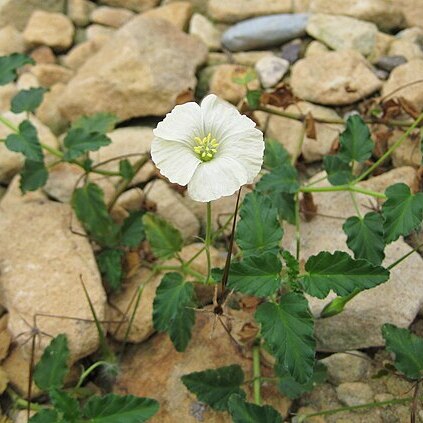Decumbent or scrambling, suffrutescent, many-stemmed, 15-40 cm high. Roots tuberous. Stems herbaceous to woody, up to about 40 cm long, 1-3 mm in diam., with a double indumentum the first of which is puberulent or pubescent with curved hairs and the second is composed oflong hay tine erect mostly gland-based hairs which are several to numerous, mostly with sessile and stalked glands, often red tinged. Leaves opposite or only the lower sometimes alternate; those of a pair unequal, the smaller leaves with lateral branches and/or inflorescences in the axil; petiole with the same indumentum as the stem, 0.4-1.3(2.2) x as long as the blade, 10-30(48) mm long, often geniculate at the apex, often flattened at the base; stipules subulate or acicular, 3-10 mm long, reddish, often subspinescent, with the same indumentum as the stem, rarely lacking the long hairs or rarely subglabrous; blade simple, narrowly ovate, ovate or broadly elliptic to narrowly triangular or triangular, small ovate leaves often at the plants' bases and large triangular leaves towards their apices, 1-2.5 x as long as Wide, 10-40 x 8-25 mm, emarginate, obtuse or acute and rarely shortly mucronate at the apex, truncate to cordate at the base, double-serrate or sinuate-serrate sometimes lobed in between the main veins, often ciliate at the margin, above puberulent with curved hairs or rarely granulate, often with sessile glands, beneath with the double indumentum of the stem or with scattered hairs on the main veins obscurely hairy to granulate or glabrous between the veins, often with sessile glands as wen; main veins subpinnate, 5 or 7 branching from the base, impressed above and prominent beneath. Inflorescences axillary, I-flowered, 45-150 mm long. Peduncles and pedicels slender, with the same indumentum as the stem; peduncles 0.2-2 x as long as the pedicels, 4-90 mm long; pedicels 20-50 mm long and geniculate under the fruit; involucral bracts 2-6 per flower, subulate, with the same indumentum as the stem or with scattered erect hairs of various lengths. Flowers often fragrant. Sepals green, free, narrowly obovate to narrowly ovate, 2-4.5 x as long as wide, 8-12 x 2-4 mm; outside pilose with gland-based hairs or with the same double indumentum as the stem, rarely with stalked glands, but sessile glands mostly present; inside glabrous, with 3 parallel main veins, margin ciliate; mucro terete, 1-4 mm long, mostly curved, greenish to brownish, with a few scattered hairs or with the double indumentum of the stem, rarely with a globuliferous pocket of resinous granules at the base. Petals obtriangular, 1.3-1.6 x as long as wide, 15-25 x 10-16mm, 1.5-2.5 x as long as the sepals, 1.5-2.5 x as long as the stamens, white, creamy, greyish Or pink, venation brownish-green, greyish-blue to greyish-maroon or purplish, with 5 main veins; outside glabrous, with scattered sessile glands; inside obscurely villose; winged, obscurely ciliate and often hairy at the base; crenate, sinuate, or entire at the apex. Stamens monadelphous, arranged in a cup-shaped column around the pistil; groups basally connate for 1-2 mm; filaments of each group basally connate for 1-2 mm; filaments in the central stamens 7-10 mm and in the lateral 5-10 mm long, mostly terete and reflexed apically, glabrous or obscurely hairy outside, glabrous inside; a transversely broadly elliptic to broadly ovate, ciliated gland or rimmed gland-cavity is situated on the outer side of the base of each group; anthers oblong, those of the long filaments slightly larger, 1.7-3 x 0.9-1.5 mm, subintrorse. Pistil 8-15 mm long; ovary obovoid to broadly obovoid, 1.5-2 x 1.5-2 mm, hyalino-hirto-pubescent; beak longitudinally grooved, 4-8 mm long, pubescent, also with stalked glands at the base; stigmas linear to clavate, 2-4 x 0.3-0.4 mm; outer surface glabrous or hairy and greenish to black, acute to obtuse at the apex, entire to obscurely dentate at the margin. Fruit 50-70 mm long; mericarps 10-15 x 2-2.5 mm and beak 30-60 mm long. Mericarps narrowly subobovoid, hirsute, obliquely domed at the apex; the tail hirsute outside, hispid inside where it detaches from the beak-axis; these stiff hairs long at the tail's base and forming a crest. Seed narrowly obovoid, 6-8 x 2 mm, glabrous. It flowers and sets fruit throughout the year, but the main reproductive period extends from September to March.
More
Herb, up to 0.4 m high. Leaves opposite, lower ones alternate; lamina simple, narrowly ovate, broadly elliptic or triangular, 10-40 x 8-25 mm, obtuse, acute or emarginate, truncate to cordate at base, double-serrate or sinuate-serrate, margins often ciliate. Inflorescences: 1-flowered; peduncle slender, 0.2-2.0 mm long; involucral bracts 2-6 per flower. Sepals: free, narrowly obovate to narrowly ovate, 8-12 x 2-4 mm, green. Petals: obtriangular 15-25 mm, white, creamy, greyish or pink, venation brownish green, greyish blue to greyish maroon or purplish with 5 main veins. Flowering time Sept.-Mar.
Sprawling or scrambling perennial with tuberous roots. Leaves entire, ovate to obovate, hairy. Flowers solitary on slender peduncles, cup-shaped, 15-20 mm diam., white, cream-coloured or pink.

